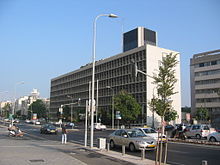World Zionist Organization
The World Zionist Organization ( Hebrew הָהִסְתַּדְּרוּת הַצִּיּוֹנִית הָעוֹלָמִית ha-Histadrūt ha-Zijjōnīt ha-ʿŌlamīt , English World Zionist Organization , WZO ) was founded at the initiative of Theodor Herzl in 1897 by the first Zionist Congress in the Basel city casino . In the Basel program , the first Zionist Congress demanded: " Zionism is striving to create a homestead protected by public law for those Jews who cannot or do not want to assimilate where they currently live."
Ha-Sochnut administrative seat
The head office, officially Bejt ha-Histadrūt ha-Zijjōnīt ha-ʿŌlamīt (בֵית הָהִסְתַּדְּרוּת הַצִּיּוֹנִית הָעוֹלָמִית House of the World Zionist Organization ), but commonly known as Binjan ha-Sochnut or Bejt ha-Sochnut (בִּנְיָן הַסּוֹכְנוּתִ or. בֵית הַסּוֹכְנוּתִ Building or house of the agency ) or called ha-Sochnut for short , is located in Tel Aviv-Jaffa on the northern side of the Rechov Kaplan between Rechov Dubnow and Rechov da Vinci , a district that until 1943 belonged to the western field region of Saronas . Benjamin Idelson and Arieh Sharon built the current headquarters of the World Zionist Organization between 1961 and 1965.
President
- 1897–1904: Theodor Herzl
- 1905–1911: David Wolffsohn
- 1911–1920: Otto Warburg
- 1921–1931: Chaim Weizmann
- 1931–1935: Nachum Sokolow
- 1935–1946: Chaim Weizmann
- 1946–1956: vacant office
- 1956–1968: Nahum Goldmann
- 1968-1972: Ehud Avriel
Executive chairwoman of the World Zionist Organization and the Jewish Agency for Israel
- 1963-1968: Simon Greenberg
- 1968–1973: Louis Arie Pincus
- 1972-1978: Yitzhak Navon
- 1973-1975: Aryeh Dolchin
- 1975-1975: Pinhas Sapir
- 1975-1976: Aryeh Dolchin
- 1976-1978: Yosef Almogi
- 1978-1987: Aryeh Dolchin
- 1987–1994: Simcha Dinitz
- 1994-1995: Yehiel Leket
- 1995–1999: Avraham Burg
- 1999-2005: Sallai Meridor
- 2005–2009: Zeev Bielski
- since 2010: Avraham Duvdevani
Central organ Haolam
From 1907 to 1950 (with minor interruptions) the World Zionist Organization published the weekly Haolam (הָעוֹלָם ha-ʿŌlam , German 'Die Welt' ) as its central organ. It first appeared in Cologne, then in various European publishing locations.
today
Today the WCO meets in Jerusalem every 4 to 5 years. Today only organizations that work for Israeli citizens can participate. The political direction does not matter.
See also
Web links
Individual evidence
- ^ Theodor Herzl: Collected Zionist Works , Volume 1, Berlin: Jüdischer Verlag, 1934, p. 189.
- ↑ In Jerusalem, however, there is also a building which is commonly called ha-Sochnut , but officially Bejt ha-Mossadot ha-Le'umijjim (בֵית הַמּוֹסָדוֹת הלְאוּמִיִּים House of National Institutions ) is called because ha-Sochnut ha-Jehudit le-Eretz Jisra'el (הַסּוֹכְנוּתִ היְּהוּדִית לְאֶרֶץ יִשְׂרָאֵל [the] Jewish Agency for Israel ) as one of these institutions has its seat there.
